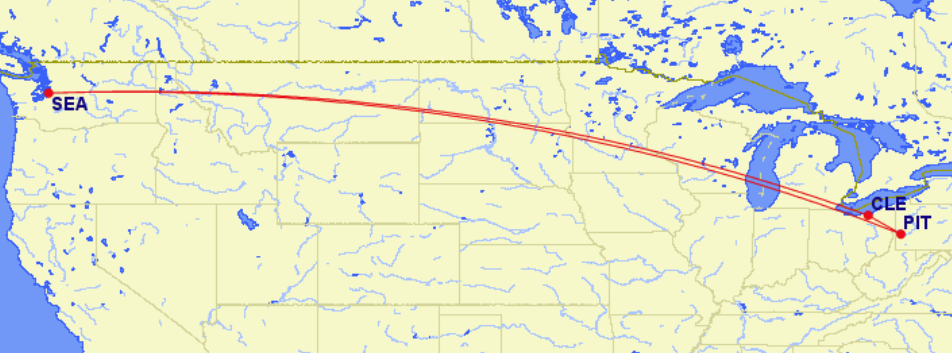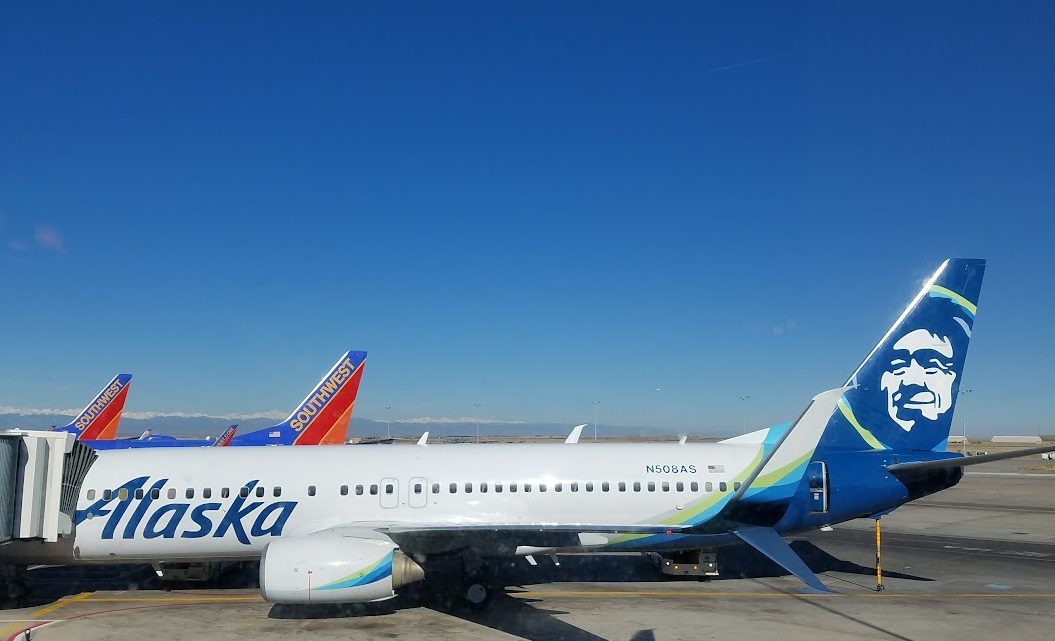Cleveland to Pittsburgh is a 106 mile flight. You can drive it in 2 hours. But Alaska Airlines is going to fly this route, and they’ll sell you a ticket for $129. But they won’t fly you back.

As noticed by enilria (‘airline backwards’), this one way route will operate January 8 – February 14 as part of a larger trip from Seattle to Cleveland to Pittsburgh and back to Seattle.
- Currently Alaska Airlines serves both Cleveland and Pittsburgh non-stop
- During the winter months these routes are expected to perform especially poorly
- Rather than exit the market for a little over 5 weeks, Alaska is going to operate the two cities together.

During this period each city will have non-stop service in one direction. You can fly Seattle to Cleveland on Alaska, but on the return need to go through Pittsburgh. You can fly Pittsburgh to Seattle, but on the return need to go through Cleveland.
Basically this type of routing is done because both flights are very weak in this timeframe and this was the only option to not close one of the stations for a short period of time. It can also be done as a result of a lack of airplanes or pilots, but since the timeframe of this oddball routing is probably the weakest time of the whole year for the Seattle market you can be sure it is more about weak loads.

Last January “[b]oth airports had loads in the 60s.” No other airline flies non-stop on these routes, so customers booking roundtrip still do better to fly Alaska in at least one direction, and in the reverse they’re still a competitive one-stop. It’s an interesting decision for Alaska to fly this as a triangle route, rather than alternating days, but makes sense as a way to dedicate fewer resources during an especially poorly-performing season (and therefore reduce losses by lowering costs) rather than closing either or both stations for several weeks.
By updating the schedule for these routes more than four months out there will be very few passengers that have already made bookings and therefore are being moved from a non-stop to a one-stop. Anyone who’s already ticketed, of course, and gets a stop added to their itinerary is entitled to a refund.


Columbus is lucky to not get this treatment
Is this really a “strange route”? Maybe from a modern, US-centric perspective, but these sorts of multi-city loop routes were historically quite common, and still are in some geographies…
Thanks for explaining the weirdness off these routes. I have noticed them on several Florida destinations. You can get there but you can’t get back unless you want tob overnight in Philadelphia. Who does that?
Instead of needing two planes and crews they can operate with one and fly the other one from Seattle to Hawaii or Mexico in peak season for those routes.
AS 445 SEA-CLE 8:00 am – 3:25 pm
CLE-PIT 4:34 pm – 5:35 pm
PIT-SEA 6:20 pm – 8:34 pm
So the stop in CLE is 1:09 and the stop in PIT is 45 minutes. I wonder if all passenger must get off the plane?
Before when Alaska served LaGuardia, I thought it would be interesting if they flew LGA-SEA with a technical stop somewhere quick, like Fargo, ND. Maybe even a quick 10 minute stop and price it so that nobody would want to board or get off. On Saturdays, when the perimeter rule is not there, then it would be non-stop.
What’s next…
They could do a DCA-xxx-SEA to add more service options. XXXX could be those cities or others like Indy, Columbus, Milwaukee, St. Louis, And others. Same with LGA
It’s a small price to pay for a 1 stop service. I applaud them for the foresight to think creatively rather than close down one city. I have flown the route to Pittsburgh and the service was Great.
So the correct description would be:
PIT-SEA = Nonstop.
CLE-SEA = Direct. (same plane, CLE passengers can stay on)
Once again a reminder that “direct” and “nonstop” are two different things.
Southwest operates a lot of direct flights, as well as a lot of nonstop flights.
Growing up in Pittsburgh, I remember this route used to exist as a Continental Beechcraft 1900 from their Cleveland hub. It’s been probably 15 years since that flight existed
Does Alaska even market something like this? How many people in Cleveland or Pittsburgh even know this route will exist
Honestly good for Alaska and reaidents of both cities. Better to have a short, direct stop than a full connection elsewhere.
Don’t see why they couldn’t do this on, say, SEA-IND-CMH either
@carletonm BRAVO !!! and BRAVO again for someone finally documenting ” correctly ” the difference in nonstop and direct air service . I hear pilots , flight crews, agents , passengers as well as announcements in the airports across this country incorrectly using direct incorrectly when it should be nonstop , which is literally nonstop service . For example from point A to point C . Direct service is with a ground stop then continuing to the final destination as explained above . For example when ending the flight in point C , the same flight flies point A to point B then ends at point C .BRAVO !!!
This is called a “round robin” in airline terminology. It faded out until Covid when Alaska was pretty creative in using it.
You know the loads on at least one of the routes must really be bad because anybody that wants to buy a CLE-SEA ticket means somebody cannot buy a SEA-PIT ticket.
I doubt AS has their own people doing these flights. They may very well be handled by AA.
These flights are always a nightmare for checked baggage as the opportunity for a bag to be pulled off in CLE when it should have gone to PIT or pulled in PIT when it should have gone to CLE is high. That’s the beauty of a one city-pair segment. All the bags get pulled off by default.
It’s interesting that they have fairly long ground time in both CLE and PIT. People will probably be required to deplane so the cabin can be serviced and so the plane can be fueled without flight attendants on board.